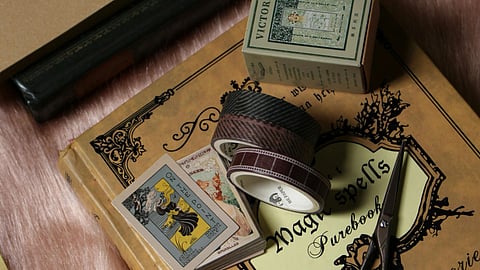
- LIFESTYLE
- FASHION
- FOOD
- ENTERTAINMENT
- EVENTS
- CULTURE
- VIDEOS
- WEB STORIES
- GALLERIES
- GADGETS
- CAR & BIKE
- SOCIETY
- TRAVEL
- NORTH EAST
- INDULGE CONNECT

We've all heard of gratitude journalling and manifestation journalling, but what about junk journalling?
As the name suggests, it involves gathering and creatively organizing bits of “junk,” like ticket stubs, old receipts, scraps of paper, or packaging, into a journal. But don’t be fooled by the term; the end result is often anything but junk.
At its core, junk journaling is a type of journaling that combines writing, scrapbooking, and collage art, often using found or repurposed materials.
Think ticket stubs, postcards, vintage book pages, washi tapes, fabric scraps, receipts, packaging, magazine clippings, and even old buttons. Anything can go into a junk journal. It's a disorganised version of you, a collection of the places you've visited, the restaurants you've been to, the hobbies you've had and the flowers you've collected.
Despite the name, a junk journal is anything but junk. The term "junk" refers more to the use of recycled or unconventional materials than to the value of the journal itself. In fact, these journals often become cherished keepsakes, full of memories and artistic experimentation. You do exactly what you feel like. It's your version of aesthetic, whatever that may be.
While junk journaling shares some similarities with scrapbooking, it's less about neat layouts and more about freeform creativity. It can be messy, unstructured, and imperfect — and that’s the beauty of it. Each page can tell a story, evoke a mood, or simply exist as a canvas for self-expression.
Some people use junk journals for daily reflections, travel logs, poetry, or art journaling. Others use them to document their healing journey, as a gratitude practice, or simply as a way to unwind.
Here's why the practice is gaining traction:
1. Eco-friendly: Junk journaling encourages upcycling and reusing everyday materials, making it a sustainable hobby.
2. Mindfulness: The hands-on process is calming and meditative. It allows people to disconnect from screens and slow down.
3. It is personalised: Every journal becomes a unique reflection of its maker. It can be deeply nostalgic, emotionally honest, or wildly whimsical.
Think of your junk journal like your closet. What do you do everyday? What's your favourite way of handing out? Where do you spend the most time of your day? What do you find aesthetic and meaningful?
For instance, you can gather sticky notes, polaroids, and quotes if you believe in the power of words. You can stick leaves and dried flowers if you travel around a lot. There are no rules.
You don’t need much to begin:
A notebook or handmade journal
Scissors and glue or tape
Ephemera (paper bits and pieces)
Pens, markers, and stamps
The rest is up to your imagination. You can start with a theme or just let each page evolve organically. Whatever you do, remember to have fun with it!
For more updates, join/follow our WhatsApp, Telegram and YouTube channels.